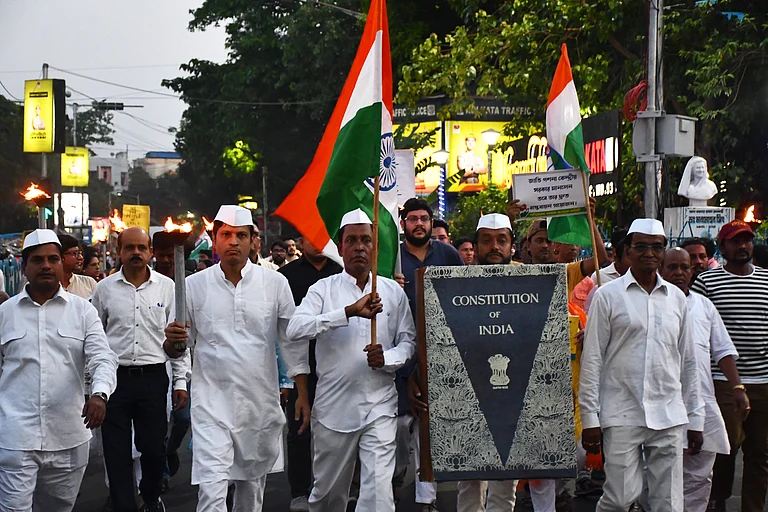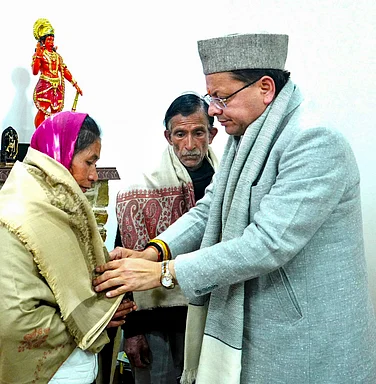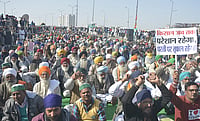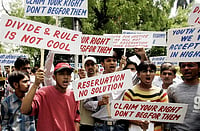A life-size portrait of the Hindutva leader Vinayak Damodar Savarkar was installed inside the Karnataka assembly on Monday, drawing flak from the Opposition Congress party.
Portrait of Sarvarkar was unveiled in the Karnataka assembly chamber in Belagavi along with other leaders, such as Swami Vivekananda, Subash Chandra Bose, BR Ambedkar, Basaveshwara, Mahatma Gandhi, and Sardar Vallabhbhai Patel. The portraits were unveiled by Karnataka assembly Speaker Vishweshwar Hegde Kageri and Chief Minister Basavaraj Bommai.
The Congress is protesting against Savarkar's portrait and saying that the decision was taken without taking the assembly into conficence.
Since it first emerged that Savarkar's portrait is going to be unveiled in Karnataka assembly, the Congress party began criticism by highlighting the controversial life of Savarkar. Congress leaders said Savarkar was involved in the Gandhi assassination case and that they were not informed about his portrait.
Here we explain who was Savarkar, he is controversial, and what's the current controversy.
Who was Vinayak Damodar Savarkar?
Vinayak Damodar Savarkar was an Indian revolutionary and a Hindu nationalist leader, who went on to become the founding father of Hindutva.
Savarkar, called Veer Savarkar by his supporters, was born on May 28, 1883 in present-day Maharashtra.
Savarkar's life can be divided in two phases — one, revolutionary anti-British phase, two, political phase devoted to Hindutva.
Savarkar's parents died when he was young and he was raised by his sister-in-law.
In 1901, Savarkar joined Ferguson College, Pune.
In 1906, Savarkar went to England to study law and made it his base for anti-British revolutionary activities.
"While a student of law in London (1906–10), Savarkar helped to instruct a group of Indian revolutionaries in methods of sabotage and assassination that associates of his had apparently learned from expatriate Russian revolutionaries in Paris," says The Britannica Encyclopaedia.
There Savarkar also wrote the book The Indian War of Independence, 1857 on the Revolt of 1957. The book irked the British and was banned. But Savarkar smuggled the book into India and it's understood to have popularised the nationalistic reading of the Revolt of 1857 as the first major independence movement.
"The book was banned before it was published in India, and a personage as senior as the Viceroy was issuing directives to prevent it from reaching the country. In a mark of the Savarkar brothers’ determination, the manuscript, after peregrinations in Europe, was published and smuggled into India at not a little expense," says historian Manu S Pillai in Open magazine.
In 1910, Savarkar was arrested for his activities and was sentenced to 50 years in prison by the British.
In 1911, Savarkar was lodged in the infamous 'Kala Pani' jail in Andaman and Nicobar Islands. He was imprisoned there for 13 years.
Savarkar's second phase starts from his incarceration in Cellular Jail, Andaman and Nicobar Islands, or, to be more specific, his release. Following his release upon acceptance of a mercy petition, Savarkar switched to political activities and turned to Hindutva and Hindu Mahasabha.
Historian Pillai has noted that Savarkar's legacy might have been totally different had the British sentenced him to death and not imprisoned him.
"[...] One is left wondering what might have happened if Savakar’s story had ended in 1911—if the colonial state had given him the noose instead of prison, would we today venerate Savarkar as we do Bhagat Singh? After all, the antipathy he arouses now is due largely to his subsequent philosophies, born at a later stage," notes Pillai.
Hindutva, Gandhi assassination case: Savarkar's controversies
Savarkar gave up revolutionary activities after being released by the British and accepted the British terms of release. He turned to Hindutva.
Savarkar is widely believed to be the Father of Hindutva. He wrote the book Essentials Of Hindutva in 1923 in which he lays out what Hindutva means.
Savarkar theorised that Hinduism is a sub-set of Hindutva, which is a broader socio-political concept, according to Shashi Tharoor's book Why I Am A Hindu.
Tharoor wrote, "Savarkar asserted: ‘Hinduism is only a derivative, a fraction, a part of Hindutva’. To him, the religion was therefore a subset of the political idea, rather than synonymous with it—something many of its proponents today would be surprised to hear."
Savarkar said that a "Hindu" is someone who considers India his motherland — matrabhoomi, the land of ancestors — pitrabhoomi, and holy land — punyabhoomi. While this definition of a Hindu is broad as it includes those too who don't identify Hinduism, this is controversial as he merged it with the idea of nation and nationality.
Tharoor notes, "Savarkar’s vision of Hindutva saw it as the animating principle of a ‘Hindu Rashtra’ (Hindu Nation) that extended across the entire Indian subcontinent, and was rooted in an undivided India (‘Akhand Bharat‘) corresponding to the territorial aspirations of ancient dynasties like the Mauryas (320 bce–180 bce), who under Chandragupta and Ashoka had managed to knit most of the subcontinent under their territorial control."
The idea of a Hindu nation and Hindus being those with ancestors and holy lands within Indian boundaries meant it excluded Muslims, Christians, and Jews as their holy lands are out of India.
Later in his life, Savarkar was accused of being involved in the assassination of Mahatma Gandhi.
On January 30, 1948, Gandhi was assassinated by Nathuram Godse in Delhi. He was a member of Hindu Mahasabha, with which Savarkar was also associated. Godse and Savarkar were acquainted for a long time when Godse killed Gandhi. In 1944, Savarkar had given a loan to Godse to start a newspaper.
It is also reported that all those involved in Gandhi's assassination had visited Godse not long before the killing.
In the case, Savarkar was number seven in the list of accused. Savarkar argued that his association and correspondence with Godse and others involved was regarding the work of Hindu Mahasabha and not Gandhi's assassination.
"That all the main accused in Gandhi’s assassination had visited Savarkar shortly before the attempts on the Mahatma’s life and that it was Savarkar’s virulent criticism of Gandhi that was at the heart of the assassins’ hatred of the Mahatma added up to a troubling grouping of circumstantial evidence against Savarkar," notes author Vaibhav Purandare.
Though Savarkar was acquitted in the case, he has often been held to be morally and ethically involved in the case.
Purandare cites two letters from Sardar Patel to Pandit Jawaharlal Nehru and Shyama Prasad Mookerjee.
Patel wrote to Mookerjee, "I have also told them [Gandhi assassination case prosecutors] that, if they come to the view that Savarkar should be included, the papers should be placed before me before action is taken. This is, of course, in so far as the question of guilt is concerned from the point of view of law and justice. Morally, it is possible that one’s conviction may be the other way about."
Patel wrote to Nehru that all the accused had given detailed statements, and "it was a fanatical wing of the Hindu Mahasabha directly under Savarkar that [hatched] the [murder] conspiracy", according to Purandare's book Savarkar: The True Story of the Founder of Hindutva.
Karnataka assembly Savarkar portrait criticism
The Congress party in its criticism of Savarkar linked him to the Gandhi assassination. It further said that the portrait has been installed without consultation.
Earlier, Congress leader and former Karnataka CM Siddaramaiah said, "There is no need for the portrait...His (Savarkar) was a controversial personality. Those who want his portrait want peace for their soul...Savarkar was among those in the Mahatma Gandhi's assassination case. He is a controversial figure. We have to see. We have not been invited for discussion for now."
(With PTI inputs)


























